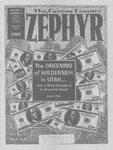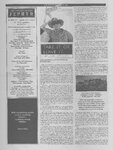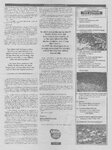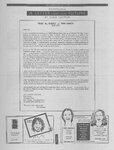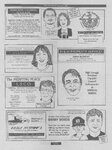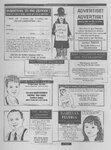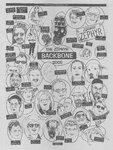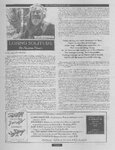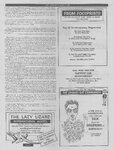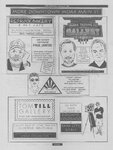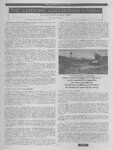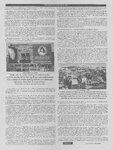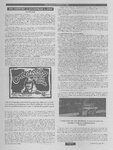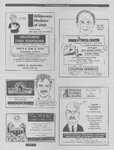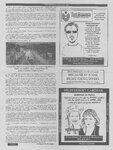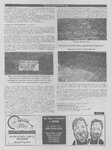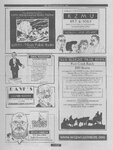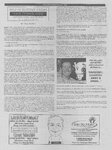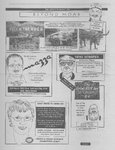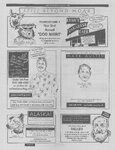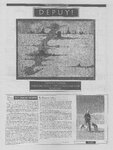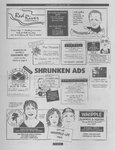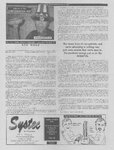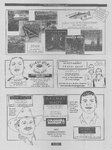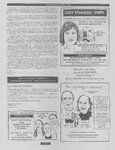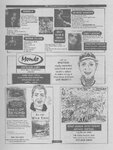| OCR Text |
Show THE ZEPHYR/JUNE-JULY 2005 AO TTA a ee (continued) Still, the philosophy of the environmental community embraced the idea of a vital “amenities economy” replacing the old one, whether many of us had misgivings about this alternate future or not. Fifteen years ago, the Sierra Club’s Lance Christie summed up the future in his Zephyr essay, “Wilderness Economics: Boom & Bust Baloney.” Lance wrote, “If a community uses wilderness amenities as a drawing card, then offers goods and services people want when they come to enjoy the local amenities, wilderness can make the people selling those goods a lot of money. If the community resents visitors and opposes wilderness for taking away the freedom to dig holes searching for treasure, then wilderness (or any tourism) won't make them money.” Christie was prophetic in more ways than one when he added a final comment, “The whole economic debate over wilderness tends to distract us from the fact that the major reasons for designating wilderness arise from non-economic values.” Indeed---yet that is exactly what happened. When Moab’s amenities economy really gathered steam in 1993, when seven motels were constructed in a matter of months and nationally franchised fast food eateries like McDonald’s, Wendy’s, Denny’s, Arby’s, Taco Bell and Burger King began to sprout along Main Street, when recreational visitation increased exponentially on surrounding public lands, none of the major environmental organizations expressed concern—not SUWA, not the Sierra Club, not The Grand Canyon Trust, not the Wilderness Society. It was as if they didn’t even notice. Except for the annual Jeep Safari itself, Moab was never much of a destination tourist center. Travelers passed through Moab as quickly as a ride to the Arches and a daily raft trip required. It wasn’t until the late 1980s, when bringing your bike to Moab was like making a trip to the Wailing Wall, that enterprising men and women everywhere began to seriously take note of Moab. Clearly Moab had achieved that special status reserved previously for places like Telluride and Aspen and Jackson, Wyoming...Santa Fe...Sedona. Just a handful of small towns around the West that suddenly, one day, discovered they had cachet....that mystical undefinable quality that makes everyone want to be able to say, “I’ve been there.” What motivated entrepreneur could miss something like that? You could hear the wheels turning inside their minds: Ifeveryone knows about Moab now, and everyone thinks Moab is a cool place to be, and if bicyclists will come here in huge numbers and spend massive amounts of money in this economy, why can’t we do the same thing with other forms of recreation? Why not a hill climb for dune buggies? Why not a rock crawling event? Why not BASE jumping? Or rock climbing? Or canyoneering? Or skydiving? Or ATV jamborees and races? Why not anything that can make us a buck and pull more visitors to Moab? Who’s going to complain? Truthfully, hardly anyone. Some environmentalists bitterly oppose the dramatic growth in the use of ATVs in Southeast Utah and the damage from these vehicles has been stunning. But how did the environmental community ever think it could limit the amenities economy to the kinds of functions and activities only they approved of? I doubt if anyone who despises the motorized recreation industry can take much pleasure from knowing that imitation is the highest form of flattery. But the truth is, after Moab cut its teeth on bikes, the sky was the limit, no matter how dissimilar the activity might seem to some. It still is. Some were loathe to praise the specific consequences of the amenities boom, and privately expressed horror at the explosive and uncontrolled growth, but no one wanted to be on the record opposing it. It was, after all, their idea. In fact, some organizations went "lf a community uses wilderness amenities as a drawing card, then offers goods and services people want when they come to enjoy the local amenities, wilderness can make the people selling those goods a lot of money." Lance Christie, Zephyr Essay. 1990 to great lengths to praise the stunning changes always in broad vague strokes. occurring in Moab and elsewhere, but Three years ago, SUWA printed a feature story in its winter issue of “Red Rock Wilderness,” their quarterly newsletter. It was called “The Local Economic Impacts of Protected Wildlands: Enhanced Economic Vitality.” It was written by Thomas Michael, Power, a Professor of Economics at the University of Montana. Power and his data asserted that protecting the rural West's wildlands did not damage local economies; on the contrary he believed that “protected landscapes are often associated with enhanced economic vitality.” But he followed that declaration with a curious caveat, considering the intent of "Even though wildlands may be good for local economic vitality, local economic vitality may not be good for the ecological integrity of those wildlands." Thomas Michael Power in SUWA newsletter, 2002 the article, that was all but ignored by environmentalists. Power warned: “This does not mean that those seeking to preserve natural areas should base their case for preservation on the economic expansion it will stimulate. That could be a dangerous strategy in the long run and one that may not be very convincing besides. In fact, in the long run, ongoing economic growth may well threaten the ecological integrity of wildlands as growing population, human settlement, and commercial activities and their accompanying pollutants isolate and disrupt natural areas. Even though wildlands may be good for local economic vitality, local economic vitality may not be good for the ecological integrity of those wildlands. (Emphasis added)” The remainder of Power's essay moves away from that warning. Using the data he had gathered, Power struck several blows in support of the amenities economy. He noted that “higher percentages of county land protected by national park, national monument, and federal wilderness status were associated with higher rates of employment.” He discovered that population growth in areas near wilderness areas was higher than state averages. And Power observed that Wilderness “protection was associated with growth rates two to six times those for other non-metropolitan areas.” FOR A ROOM WITH A VIEW When Thomas Power set out to analyze the effects of wilderness on the rural economy, by the growth of population in western Montana, despite low wages and incomes, studied the location of new residential housing to determine what locational characteristics explained the decisions homebuilders were making. They found that the closer a location was to a designated wilderness area, the higher the likelihood of new construction. The same was true of national parks.” Power’s bewilderment is old news to most of us who live in small communities near parks and wilderness. New home construction, which took off in Moab during the early 90s, is often intended for part-time residents, people who have no intention or need to seek employment in the area. In fact, these homes and condominiums are in a way, very disconnected from the socio-economic needs and difficulties of the community to which they have, at least physically, joined. They exist in something of a vacuum, because somany Power concluded, despite his early warning, “It’s is not clear why wildlands advocates would not want to meet the economic critics of wildland protection on their own ground, while also continuing to make the ethical, cultural, and environmental arguments. After all, if you can take away the only powerful argument the anti-environmentalists have, why would you not do so?” It was as if he was saying, we can let the anti-wilderness people destroy the West on their terms or we can fight to destroy it on our terms. And aren’t our terms of destruction better than theirs? After all, before we destroy the wilderness, we're going to protect it. Environmentalists failed to see or would not acknowledge the double-edged sword Power offered. In a subsequent issue of “Red Rock Wilderness,” SUWA attempted to put its own spin on Power's report with some additional numbers of its own. SUWA noted that, “Total employment in Utah has increased by 45% in the last decade...What is fueling Utah’s pacesetting growth? Tourism and related services have been doing well...has been especially robust, and now provides more than a third of all jobs....Growth is not limited to urban Utah. In Grand County, a tourism explosion helped to make it the third fastest growing county in Utah.” All of this was told with almost evangelical enthusiasm. LOOKING he noted an anomaly that he could not initially explain. “Researchers,” he wrote, “puzzled None of Power's warnings saw the light of day in this particular spin. Finally SUWA noted the ballooning Utah population, which grew by 30% in the 1990s. “This tremendous regional growth, with Utah at its epicenter, is driven by Western quality of life factors like outdoor recreation, open space, and wilderness....There is a very real place for wilderness in Utah’s economic future. Protected by BLM, wilderness can serve as a modest sustainable source for economic well- being and community development.” There’s nothing“modest” about Moab’s transformation in 2005. Some environmentalists might argue that much of the explosive change in Moab has nothing to do with their efforts to support a clean, upscale amenities economy. The rowdy raunchy Jeepers and the noisy noxious ATVs and the rabid Rock Crawlers seem to have nothing much in common with the leg-powered bicycle as a recreational diversion. It might be fairer to suggest that the amenities economy backfired in the environmentalists’ very own faces. of these part-timers are oblivious to the issues and problems that affect the town. They don’t know much of the town’s history and know few of its citizens, they don’t get involved in local politics and don’t vote. They do pay taxes and they don’t impact the educational system because most part-time residents don’t have school-age children, but they still demand the services that they believe their tax dollars entitle them to. In almost every case, this kind of second home it tively impacts the tax base; in other words, when J o towns grow in this fashion, everyone pays more. And what about the land upon which these homes are built? Almost always, in the small towns of the Rural West, new residential developments are built on what was agricultural or grazing land. Once again the “cows versus condos” debate raises its persistent head. No environmentalist, worth his organically-grown natural sea salt, has much patience for the West's cattle industry and especially public lands grazing. And the damage caused by some ranchers is well-documented and disgraceful. I lose patience with ranchers who abuse and destroy the very land they make a living from, but I try to avoid painting all ranchers with the same broad stroke. Ranchers run the spectrum like everyone else. If someone, for instance, tried to tell me that rancher Heidi Redd didn't understand the heart and soul of the American West, I'd have to hurt them in some slow and tortuous way. Heidi has lived most of a life at Dugout Ranch in San Juan County, Utah and I'm glad she's there. But while some environmentalists may believe that paving over alfalfa fields with something like Rim Village is striking a blow for Mother Nature and the New Economy of the West, we should remember Thomas Power's warning about the long-term view of this kind of development. Runaway tourism/growth/expansion of towns like Moab should cause all of us to take notice and give pause--to re-think all of this. Exploding tourist numbers and a ‘second home culture’ transform a community, shift the emphasis of the town away from the people who live there and toward the tourists who don't. Moab doesn't exist for its citizens; it's there, in fact, for high dollar transients. And it rarely benefits the small-town residents that were there during the tough times; it's the new arrivals with the capital to invest that flourish. ; é PAGE 16 |
